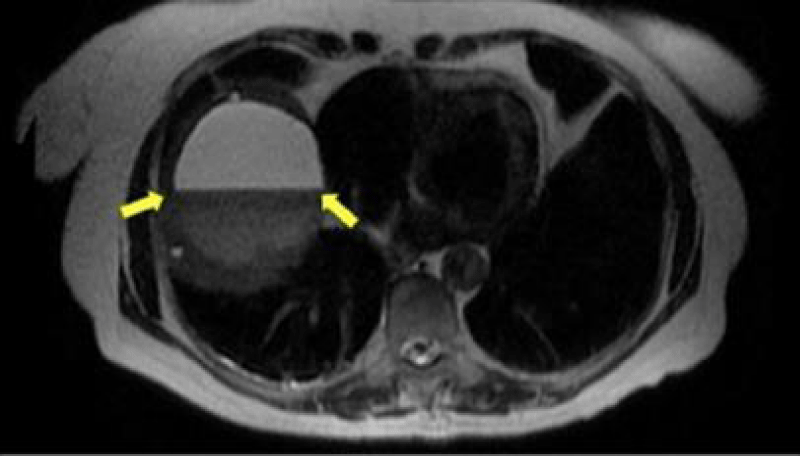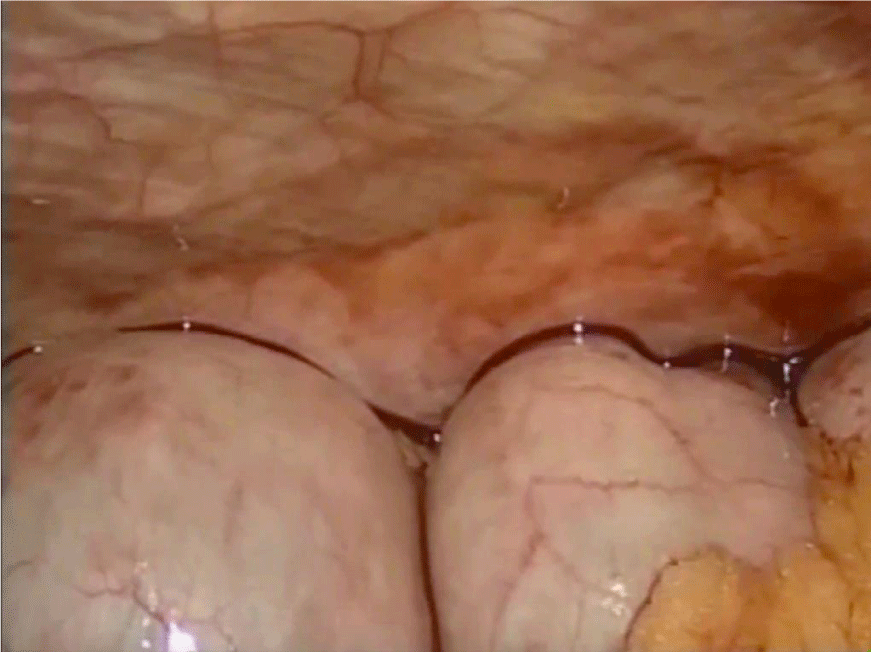Hemoperitoneum Caused by Rupture of Hemorrhagic Simple Liver Cyst-A Rare Complication
Marcelo D Oliveira1,5, Klaus Steinbruck2-5*, Luiza Basilio Rodrigues1,5 and Marcelo Enne1,4,5
1Hepatobiliary Surgery, Ipanema Federal Hospital, Health Ministry, Rio de Janeiro, Brazil2Hepatobiliary Surgery, Bonsucesso Federal Hospital, Health Ministry, Rio de Janeiro, Brazil
3Department of General Surgery, Gaffreé Guinle Universitary Hospital, Federal University of the State of Rio de Janeiro, Rio de Janeiro, Brazil
4Fellow of American College of Surgeons - FACS, USA
5Equipe Multidisciplinar Hepatobiliar, Rio de Janeiro, Brazil
*Address for Correspondence: Klaus Steinbruck, Hepatobiliary Surgery Unit, Bonsucesso Federal Hospital - Health Ministry, Rio de Janeiro, Brazil, Tel: +552-139-779-811; E-mail: steinbruck@gmail.com
Submitted: 30 December 2019; Approved: 21 January 2020; Published: 24 January 2020
Citation this article: Oliveira MD, Steinbruck K, Rodrigues LB, Enne M. Hemoperitoneum Caused by Rupture of Hemorrhagic Simple Liver Cyst-A Rare Complication. Open J Surg. 2020;4(1): 005-007.
Copyright: © 2020 Oliveira MD, et al. This is an open access article distributed under the Creative Commons Attribution License, which permits unrestricted use, distribution, and reproduction in any medium, provided the original work is properly cited
Keywords: Liver; Cyst; Hemoperitoneum
Download Fulltext PDF
Simple liver cysts are congenital or acquired benign cysts formations and are commonly found incidentally. It has a prevalence of 3-5% in ultrasound studies and 18-24% in CT scans. Frequently asymptomatic, liver cysts may be associated with symptoms in 10-16% of patients. Hemoperitoneum is a far rare complication. Herein, we report a case presented at the emergency room with acute hemorrhagic rupture of a liver cyst.
Abbreviations
CT: Computed Tomography; MRI: Magnetic Resonance Imaging; POD: Post-Operative Day
Introduction
Simple liver cysts are congenital or acquired benign cysts formations and are usually found incidentally during imaging exams. It has a prevalence of 3-5% in ultrasound studies and 18-24% in CT scans [1]. Frequently asymptomatic, liver cysts may be associated with symptoms in 10-16% of cases [1]. Complications that can occur from a liver cyst include pain, development of spontaneous hemorrhage in 2-5%, infection in 1% and obstruction (biliary, vascular) in 3-9% [2]. Hemoperitoneum is a far rare complication, with only few cases described in the literature. Herein, we report the case of a patient that presented an acute hemorrhagic rupture of a liver cyst.
Case Presentation
A 74-year-old healthy woman was admitted at emergency room with a sudden and important abdominal pain. Physical examination revealed pale mucosa, tachycardia and peritoneal irritation with rebound tenderness. Laboratory tests confirmed hematocrit and hemoglobin diminished levels. CT scan and MRI demonstrated an 8 cm cystic lesion with an air-fluid level in segments VII - VIII of the liver (Figure 1) and free fluid in the abdominal cavity (Figure 2). She underwent laparoscopy that demonstrated a moderate volume (60cc) of blood in peritoneal cavity (Figure 3). The cyst was adhered to the right diaphragm. During detachment, a bleeding rupture point of the cyst wall was identified (Figure 4) and controlled with bipolar cautherization. Approximately 150cc of hematic fluid was evacuated from within the cyst and unroofing of the superior wall was carried out. Surgery was finished by saline irrigation and drainage. Patient remained stable and received no transfusion. Abdominal drain was removed on the 3th POD and patient was discharged at the same day. She is in good shape and asymptomatic 21 months after surgery.
Discussion
Hepatic simple cysts are frequently encountered nowadays with improvement of imaging techniques. Bleeding within a simple cyst has a prevalence of 2-5% [2]. Normally, this event courses with acute abdominal pain, but no specific treatment is necessary. In very rare cases, hemorrhage inside the cyst may cause rupture of its wall leading to hemoperitoneum. To the best of our knowledge, there are only 13 cases described [2,3], including our patient, of hemorrhagic liver cyst rupture.
According to a review carried out by Marion, et al. [2] in 2013, six out of eleven patients with hemorrhage and rupture of hepatic cyst had hemodynamic decompensation, with three deaths. Nine patients were submitted to surgery or interventional procedure with eight favorable outcomes, showing how important intervention can be in this scenario. In our case, the patient presented with hemodynamic impact, which led us to perform surgery, instead of observation.
The principal hypothesis for this complication is that a progressive increase in cyst volume raises intracystic pressure inducing necrosis in internal layers, exposing blood vessels of the outer layers of the cyst wall. This exposition may cause breach of this vessels and intracystic bleeding [4], which is normally spontaneously stopped by the high pressure inside the cyst, without major consequences. If a cyst rupture occurs, due to high internal pressure, bleeding can be continuous, and become life threatening. To the present day, no definitive etiology has been confirmed as a causative factor of this rare and important complication. Marion, et al. [2] observed that three of the eleven patients reviewed had hepatorenal polycystic disease, and needed specific treatment, with dialysis or use of anticoagulants, which may have increased the risk of hemorrhage. In 2016, Hasma, et al. [3] described a case of sudden death in a 22 years-old patient associated to stanozolol abuse. Although this is not among the more common hepatotoxic adverse effects from anabolic steroid use, the author highlighted that clinicians and pathologists should be aware of this possible association of anabolic steroids and hemorrhagic rupture of liver cyst. If no possible risk factor is identified, differential diagnosis of hemorrhagic hepatic lesion with cystadenocarcinoma or cystic necrotic tumor is of upmost importance and pre-operative MRI is the method of choice for evaluation.
Conclusion
As hemorrhagic liver cyst rupture is a rare and potentially life-threating complication of simple liver cysts, any new case is important to be described and should be studied to better understanding of this pathology, helping us to prevent it, and maybe indicate surgical treatment earlier.
- Fong ZV, Wolf AM, Doria C, Berger AC, Rosato EL, Palazzo F. Hemorrhagic hepatic cyst: report of a case and review of the literature with emphasis on clinical approach and management. J Gastrointest Surg. 2012; 16: 1782-1789. PubMed: https://www.ncbi.nlm.nih.gov/pubmed/22688416
- Marion Y, Brevart C, Plard L, Chiche L. Hemorrhagic liver cyst rupture: an unusual life-threatening complication of hepatic cyst and literature review. Ann Hepatol. 2013; 12: 336-339. PubMed: https://www.ncbi.nlm.nih.gov/pubmed/23396748
- Hansma P, Diaz FJ, Njiwaji C. Fatal liver cyst rupture due to anabolic steroid use: A case presentation. Am J Forensic Med Pathol. 2016; 37: 21-22. PubMed: https://www.ncbi.nlm.nih.gov/pubmed/26704022
- Takahashi G, Yoshida H, Mamada Y, Taniai N, Bando K, Tajiri T. Intracystic hemorrhage of a large simple hepatic cyst. J Nippon Med Sch. 2008; 75: 302-305. PubMed: https://www.ncbi.nlm.nih.gov/pubmed/19023172





Sign up for Article Alerts